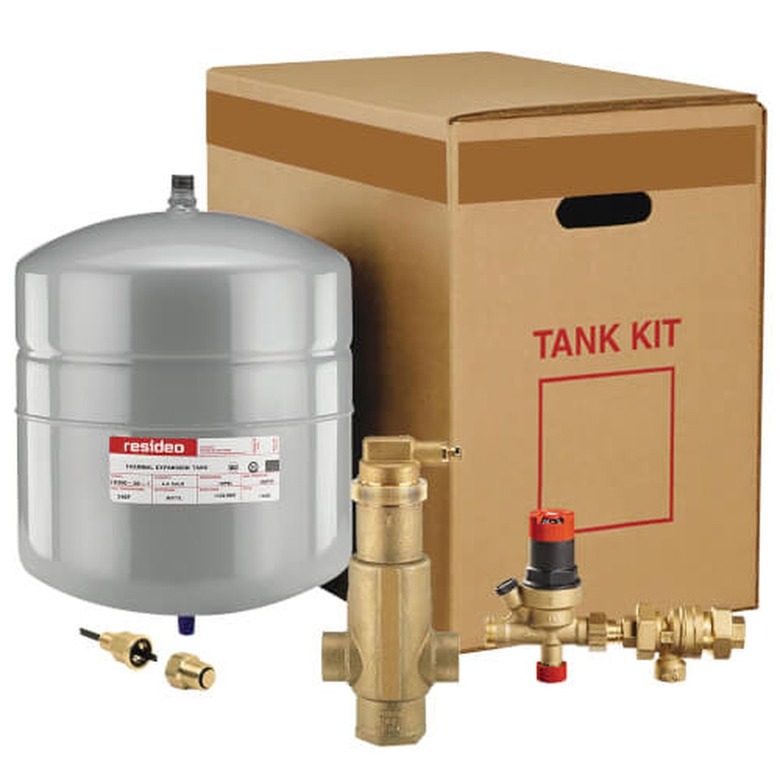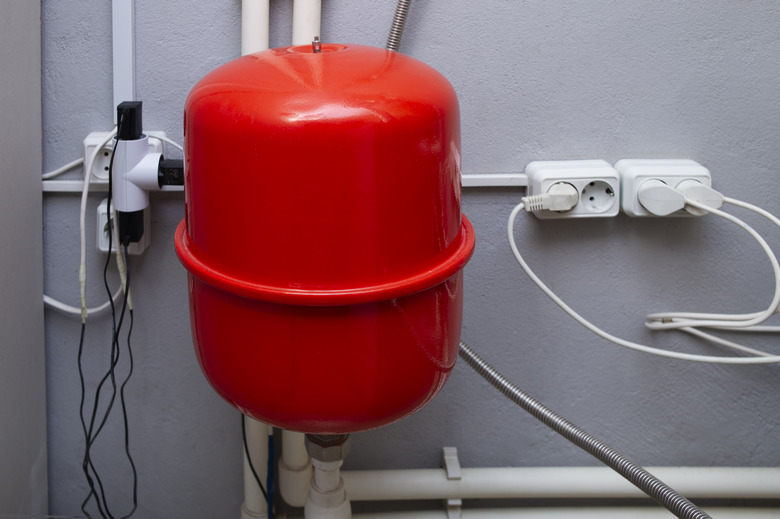What Is A Water Heater Expansion Tank? Here's What You Need To Know
We may receive a commission on purchases made from links.
Ice floats because water expands when it's freezing — which is one of the amazing characteristics of this life-giving liquid — but water also expands when it heats up, and that's why your water heater might need a thermal expansion tank. Without a reservoir to absorb the extra volume of hot water, your water heater tank is at risk of leaking and even bursting. If you have a hydronic heating system, your boiler also needs an expansion tank.
An expansion tank isn't an expensive add-on, and if you have basic plumbing skills, you don't need to call a plumber to install it. Even if you do call a plumber, it shouldn't cost much. It's a fairly simple job that you can do in about an hour and that a licensed plumber can do in even less time. Not only will it prevent the potential disaster of a leak or explosion but it will preserve the warranty on your water heater.
Tip
Because water expands when heated, a water heater expansion tank absorbs the excess water from a closed water heater or boiler system.
What Is an Expansion Tank?
What Is an Expansion Tank?
A water heater expansion tank looks like a small version of a well pump pressure tank, and it works on basically the same principle. A typical expansion tank is a metal cylinder with a rounded top and bottom that has a volume from 2 to 5 gallons. It has a water inlet on one end and an air valve similar to the one on a bicycle tire on the other. The interior is coated with a polypropylene liner approved by the U.S. Food and Drug Administration that is safe for potable water and is separated into two sections by a butyl rubber membrane that creates two compartments: one for air and the other for water.
You charge the tank by pumping air through the air valve using a bicycle pump or a compressor. When you connect the water port to the hot or cold water pipe near the water heater or boiler, expanding water can enter the water reservoir, thus relieving stress on the water heater or boiler tank. When the temperature falls and the water volume contracts, the pressurized air pushes the water back out to maintain the volume in the water heater or boiler tank.
Do I Need an Expansion Tank?
Do I Need an Expansion Tank?
If you're on a municipal water system, cold water enters your home through a metered port that may have a pressure reducing valve or pressure regulator. In the past, this supply port was always open and provided a path for expanding water to back up into the municipal supply. These days, most authorities require backflow preventers or check valves just after the meter or the pressure reducer to eliminate the possibility of backflow and contamination. These valves create a closed system, and whenever they are installed, an expansion tank is a code requirement.
If you aren't sure whether your system has a check valve, look for one in the cold water supply pipe somewhere between the meter and the water heater. A pressure regulator, which is a conical brass fitting with a turnable nut on the top, usually has a built-in check valve. If you don't have a pressure regulator, look for an inline fitting the same diameter as the pipe; this is likely to be a check valve. If you aren't sure, consult a plumber
Hydronic heating systems are closed-loop systems by design and always need expansion tanks. That's because the water inlet port remains closed unless the system calls for water. If your house has one of these hot water heating systems, it probably already has an expansion tank mounted in the hot water line exiting the boiler.
Sizing an Expansion Tank
Sizing an Expansion Tank
Water expansion doesn't vary linearly with temperature; it has an exponential relation, which means that the rate of expansion increases with temperature. What this means for homeowners sizing their water heater expansion tanks is that the volume of the water heater, the water pressure, the initial and final temperatures of the water in the water heater tank, and the pressure at which the relief valve on the water heater opens all factor into the optimum size for the expansion tank.
That's a lot for any homeowner to try to figure out, but fortunately, homeowners don't have to figure it out. Multiple sites, such as Watts, have online sizing calculators. Generally, if you have an 80-gallon water heater, you need a 5-gallon expansion tank regardless of the incoming water pressure. A smaller home with a 40-gallon water heater needs only a 2-gallon tank unless the incoming pressure is 80 psi or more, which is very high considering that residential water pressure should generally be from 40 to 60 psi.
If you don't know your home's water pressure, all you need to measure it is a pressure gauge that you can screw onto one of the threaded faucets outdoors or in the laundry room. After screwing the gauge onto the faucet and opening the faucet all the way, you can read the pressure directly from the gauge. If you're on a municipal system, the utility company should also be able to tell you the water pressure. When in doubt, always choose a larger expansion tank than you think you need because if you undersize it, it won't provide the necessary protection.
Installation of an Expansion Tank
Installation of an Expansion Tank
Although you can install an expansion tank on either the cold water supply going into the water heater or the hot water supply coming out, the general practice is to install it on the cold water line. The tank has to go on a horizontal run of pipe — not a vertical one — and it should be indoors in a place that is not subject to freezing. It should be at least 18 inches from the point at which the cold water line enters the water heater tank. An expansion tank can be supported by the pipes if they are secure enough, but it's a better idea to strap it to wall studs, and most come with the strapping and brackets necessary to do this.
Before you install an expansion tank, you need to charge it. Most tanks come from the factory pre-charged to a pressure between 20 and 40 psi, and you need to increase this to equal the water pressure in the building by pumping air through the air valve. The easiest way to do this is to use a compressor with a built-in gauge, but you can use a bicycle pump and a tire pressure gauge in a pinch. Once the unit is charged:
- Turn off power to the water heater (if it's electric) or turn off the gas control valve (if it's gas) and open hot water faucets in the house to relieve pressure. It's a good idea to wait a few hours for the water to cool.
- Install a tee in the cold water supply line between the shutoff valve and the water heater. You can usually do this by unscrewing the water heater flex line from the shutoff valve and screwing the tee onto the valve. The tee should have a 3/4-inch threaded outlet so you can install another flex line that goes to the expansion tank. The actual procedure varies according to the configuration of the water heater and the supply line. In some cases, it may make more sense to install the tee in the horizontal length of pipe that leads to the water heater.
- Screw the water heater flex line onto the horizontal port of the tee and screw another flex line for the expansion tank onto the vertical port. Remember that the total distance from the water heater inlet to the expansion tank must be at least 18 inches, so use a flex line that's long enough to accommodate this distance. Screw the other end of that flex line to the expansion tank. Wrap plumbing tape around the male threads of each connection to prevent leaks.
- Open the shutoff valve and let the water heater fill. Purge air bubbles by turning on hot water faucets in the house and letting them run until they stop spurting. You can also purge air from the drain valve on the water heater tank after first screwing on a garden hose.
- Turn the power back on and let the water in the tank heat up to its preset temperature.
The Cost of an Expansion Tank
The Cost of an Expansion Tank
Expansion tanks aren't very expensive. The total cost including the flex line and tee connector is roughly between $40 and $80. Mounting brackets and strapping, if you need them, may cost between $60 and $200.
If you do the installation yourself, you may incur an extra $60 or more in expenses for extra pipe, tools, and other materials. Homeowners who opt for professional installation by a plumber or HVAC technician can expect to pay from $150 to $350 extra in service fees depending on the configuration of the pipes and the water heater.
Maintaining Your Expansion Tank
Maintaining Your Expansion Tank
Like everything around the house, you need to check the water heater thermal expansion tank periodically. The top of the tank should feel warm when you put your hand on it, while the bottom should feel cool. If the entire tank feels warm, that could indicate that the internal membrane has ruptured, in which case you should replace the expansion tank immediately.
Another sign that the expansion tank isn't doing its job is a frequent release of pressure by the water heater's temperature and pressure relief valve. You'll know this is happening if you often see water on the floor underneath the valve's discharge tube. This valve shouldn't be opening if the expansion tank is working, and it indicates excess pressure in the water heater tank. If you allow this condition to persist, the water heater tank could be damaged, so call a plumber to diagnose the expansion tank and replace it if necessary.
References
- ServiceMark: What Is a Water Heater Expansion Tank and Why Do I Need One?>
- Costimates: Compare Water Heater Expansion Tank Installation Costs
- State Water Heaters: Water Heater Thermal Expansion Tanks Owner's Manual
- InspectAPedia: Hot Water Thermal Expansion Rate
- Watts: Expansion Tank Sizing Calculator (Potable)
- YouTube: How2Plumb – How to Install An Expansion Tank

